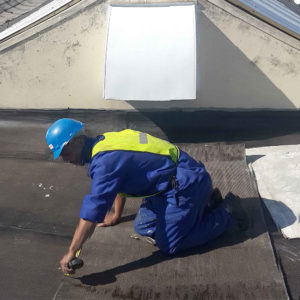Waterproofing is a construction measure preventing water damage to external areas of a building, as well as internal areas and assets, also protects the building against chemicals. It is often a grudge purchase which may lead to cheaper materials used or requirements being reduced for the property, contrary to professional suggestion.
However, it is vital to improve longevity of a building and avoid additional costs for repair work or re-waterproofing.
Causes of system damage
Water ingress can occur due to:
- Poor waterproofing system design
- Poor quality or unsuitable waterproofing materials / incorrect specification
- Bad workmanship
- Damage to an installed waterproofing system – Workers in other trades may not know how to take care of waterproofing systems, hammering nails / screws through them to fit solar panels, air-conditioning units, television aerials and lightning arrestors
Types of waterproofing available
There are many waterproofing systems, but the system used must be suitable to the property area and applied correctly. Main systems in South Africa are Atatic Polypropylene (APP) Modified Bitumen Torch-on Membranes, Acrylics, Polyurea, Polyurethanes and Cementitious. Polyurea is a high performance amine cured elastomeric that provides excellent flexibility, abrasion and tear resistance and is suitable for below ground applications.
There also seems to be an increase in using additives in concrete mixes and liquid waterproofing coatings as alternatives to Torch-On Membranes. Two main products are crystalline admixtures and a hydrophobic additive applied during the concrete mix stage which blocks pores in concrete preventing water passing through it. Crystalline-treated concrete will react with the presence of moisture in the event of a static crack occurring. The bridging of limited size cracks occur over time and will render the crack leak-free as long as the crack is static. A dynamic crack however, will need further treatment or an additional capping membrane such as Torch-on.
Ways to apply the system
An applicator must have knowledge of the substrate and the waterproofing system to be applied to ensure a watertight installation of the suitable system.
- Torch-on Membranes: Installed with an open flame by means of propane gas to heat the Bitumen torch-on Membrane to a molten state for the effective adherence to a prepared and primed substrate. The waterproofing is watertight immediately after installation due to the pre-manufactured membrane and hydrophobic properties of the bitumen.
- Polyurea: Two component liquid system heated to above 60⁰C and processed through an air purged spray gun. The two components are mixed at temperature through an impingement mixing head at >2000Psi pressure. These high pressure spray machines are sophisticated and highly expensive. Although Polyurea has a gel time of only a few seconds, curing times are 24hours to 7days to reach full cure at 25⁰C.

- Polyurethane, Acrylic and Cementitious: Liquid applied by brush, roller or low-pressure spray. Easier to apply compared to Polyurea, however application times are much slower.

Testing the waterproofing
A common method to ensure waterproofing is watertight is the 48 Hour Flood Test involving SANS 10400 requirements of:
- Blocking all outlets and flooding the roof with water so all surface areas are at least 3mm under water
- Monitoring depth of water
- Inspecting interior building for leaks
- Checking correct screed to falls
- Checking allowable moisture content of substrates
- Checking number, size and positioning of outlets
- Checking finishing of internal and external corners
- Installing 45-degree fillets for wall to floor corners
- Checking termination details
- Determining DFT’s (Dry film thicknesses) of liquid applied systems. Not applicable to Torch-on systems.


Consult an expert
Waterproofing is a rapidly changing, complex field so it is critical to speak to an expert before waterproofing any property to avoid costly mistakes and achieve successful results. The waterproofing company should have a verifiable track record and should help you choose correct products for waterproofing installation, train their applicators to use best practice when installing products and inspect projects during application so best practice continues on-site. Architects are recommended to partner with DWASA members to receive correct waterproofing advice. DWASA have a standard of conduct between members and clients and advise on skills training for members to skill employees in waterproofing.

Full thanks and acknowledgement are given to a.b.e, BMI and DWASA for the information in this article.

